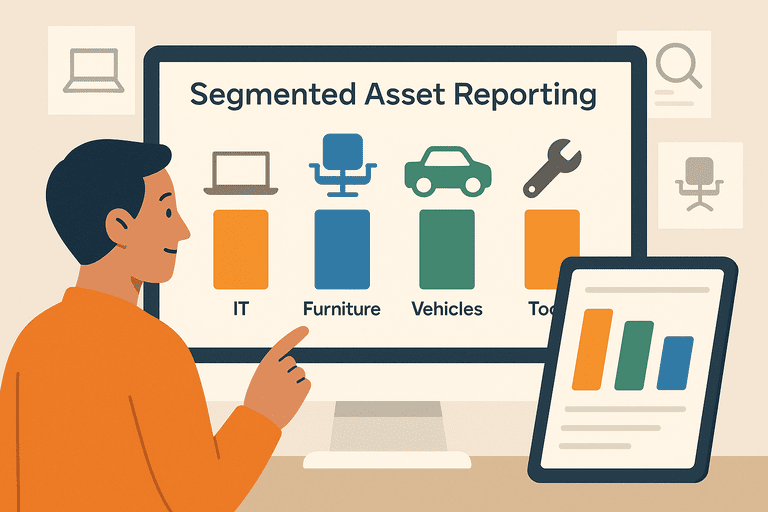How to Segment Asset Classes for Better Reporting
Learn how to segment asset classes effectively to improve financial reporting, maintenance planning, and operational insights.

Introduction
Accurate asset reporting starts with clear segmentation.
Whether you’re managing IT devices, furniture, tools, or vehicles, grouping assets into logical, well-defined classes helps you analyze performance, costs, and utilization with precision.
Yet, many organizations fail to apply structured asset segmentation, leading to inconsistent data, messy reports, and unreliable financial statements.
This article explains how to organize asset classes to align with your business objectives and produce more insightful, audit-ready reports.
1. What Is Asset Segmentation?
Asset segmentation is the process of categorizing physical and digital assets into meaningful groups based on attributes like function, location, lifecycle, or ownership.
In accounting terms, asset classes often map to depreciation methods or balance sheet categories.
In operations, they help track usage, maintenance, and replacement cycles.
A well-designed classification system improves both financial accuracy and operational visibility.
2. Why Segmentation Matters for Reporting
| Benefit | Description |
|---|---|
| Financial Clarity | Easier calculation of depreciation, ROI, and asset valuation |
| Operational Insights | Understand usage trends and condition by category |
| Maintenance Optimization | Predict servicing needs based on similar asset groups |
| Compliance and Auditing | Provide clear traceability for inspections and reporting |
| Scalability | Simplify integration with accounting and ERP systems |
Without segmentation, reporting becomes inconsistent — especially across departments or locations.
3. Common Asset Class Structures
Here’s how businesses typically structure their asset classes:
By Function
- IT Equipment (Laptops, Servers, Monitors)
- Office Furniture (Desks, Chairs, Cabinets)
- Vehicles (Fleet, Forklifts, Scooters)
- Tools & Machinery
- Facilities & Fixtures
By Department or Cost Center
- Marketing
- Operations
- Engineering
- Sales
- Facilities Management
By Location
- HQ vs Remote Offices
- Regional Branches
- Warehouses vs Retail Outlets
By Lifecycle or Status
- Active
- In Maintenance
- Retired / Disposed
- On Loan / Assigned
The right structure depends on your reporting goals — financial, operational, or both.
4. Designing a Segmentation Framework
Follow this 5-step process to create a reporting-friendly classification system:
Step 1: Define Reporting Objectives
Decide what you want to measure:
- Depreciation by asset type?
- Maintenance cost by department?
- Asset turnover by region?
Step 2: Create Hierarchies
Start broad, then drill down.
Example:
IT Equipment
├── Laptops
├── Monitors
├── Servers
└── Peripherals
Step 3: Assign Attributes
Every asset class should include:
- Category name
- Description
- Expected lifespan
- Depreciation method
- Responsible department
Step 4: Align with Accounting
Map each class to corresponding GL codes or depreciation categories in your accounting software.
Step 5: Standardize and Enforce
Use naming conventions and data validation rules to prevent duplication and ensure consistency across teams.
5. Reporting Use Cases by Asset Class
| Use Case | Example Metric | Insights Gained |
|---|---|---|
| IT Equipment | Total cost of ownership (TCO) | Identify outdated devices |
| Vehicles | Maintenance cost per mile | Detect overused units |
| Furniture | Utilization rate | Optimize workspace allocation |
| Tools & Machinery | Downtime vs usage hours | Plan preventive maintenance |
| Shared Equipment | Check-in frequency | Track high-demand resources |
Each class becomes a lens through which you can analyze performance and cost-effectiveness.
6. Common Mistakes to Avoid
| Mistake | Problem | Solution |
|---|---|---|
| Overcomplicating Classes | Too many categories dilute visibility | Focus on business-critical ones |
| Mixing Functional and Financial Grouping | Leads to confusion in reports | Separate operational vs accounting hierarchies |
| Ignoring Depreciation Rules | Inaccurate balance sheets | Align with accounting standards |
| Inconsistent Naming | Duplicate or missing assets | Use standardized codes |
A clean taxonomy ensures clarity for both finance and operations teams.
7. Example: Asset Class Reporting in Action
A medium-sized company divides assets into:
- Class: IT Equipment → Category: Laptops
- Class: Office Furniture → Category: Desks & Chairs
- Class: Vehicles → Category: Electric Vans
Each class links to its own depreciation schedule, responsible department, and cost center.
When finance pulls reports, they can see:
- Depreciation per class
- Remaining book value
- Maintenance cost per location
The result: clear financial reporting and data-driven decision-making.
8. Automation and Integration
Modern inventory platforms simplify segmentation with:
- Dynamic filtering by category or tag
- Automated depreciation per asset class
- Integration with ERP and accounting APIs
- Role-based dashboards for department-level reporting
Automation ensures updates propagate instantly across systems — no manual exports or reconciliations.
Conclusion
Effective asset segmentation transforms messy data into structured intelligence.
By classifying assets consistently, you gain cleaner financial reports, better forecasting, and higher accountability.
A well-defined asset class framework isn’t just administrative — it’s the foundation for smarter, data-driven management.
Explore more reporting and optimization topics: